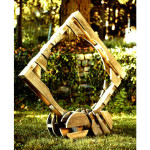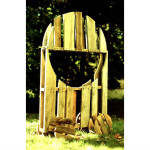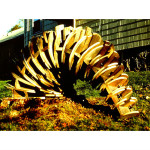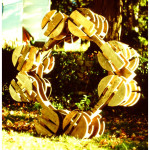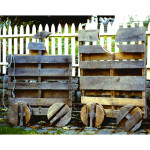Moving to urban neighborhoods around Boston, I turned to “carving” the freight pallets found in abundance.
Then and now, I find my freight pallet sculptures uninspired. In a way they were a “rebound medium.” When I relocated to Boston I left behind my stone carving studio and my endless supply of stone. Stone had become my first artistic love. I had begun to find my artistic sensibility with stone and there is a feeling of magic and completeness in that.
As I looked around my new urban environment, I sought a medium that had those same qualities I had come to love in stone. Freight pallets seemed to be the urban equivalent to the rural field stone. They seemed to be everywhere, cast off to the side. Being free and abundant were really the only qualities pallets and field stone shared but it took a lot of uninspired work to figure that out.
It wasn’t the pallets’ fault they lacked the geological and historical depth of a field stone, that they lacked the surprise. In the end it was my expectations and lack of imagination that kept these pieces from being more transformative.
This short relationship was not without its benefits. The site-specific installation Immobile Rolling Sculpture grew out of this experience, and, in a way so did Silent Suburb. Maybe most importantly, the uninspired nature of the work pushed me to explore something completely new, installation art. (Yes, this is meant to be a bit silly so its OK to laugh, or roll your eyes.)
There are some artists who have done some interesting work with freight pallets. Check out the Pallet Pavillion (interior views) or the Dream Weaver Pavillion.
One way to cultivate creativity is to make art from the mundane. There is tremendous merit in experimenting with a range of common everyday objects without any preconceived notions. Simply handle the media and reflect on, and then play up, its inherent characteristics. One of the better classes I took in art school was called “A Material a Week.” Each week a new medium was presented to the class. The common items included large sheets of cardboard, hair, toothpicks, tar paper, aluminum foil, Styrofoam cups, tongue depressors, rope, beads, spaghetti, etc. After a week of exploring on their own an object’s expressive potential, the class reconvened to share and critique the resulting work. The range of responses was amazing as students not only drew on the inherent characteristics of a medium, but also tapped into historical, social, and personal connections. The critiques were supported with slide shows of work that either used the same materials or drew on the same qualities within the materials. For example if you are working with hair, show:
- Tom Friedman’s beautiful, funny, and icky hair spiral or his hair tarantula
- Keith Bentley’s horse hair Cauda Equina
- Sonya Clark’s insightful and provocative hair art or even her Comb Series
- Ana Mendieta’s facial hair transplants
- Nagi Noda’s Hair Hats
- Oreet Ashery’s performance piece Hairoism
- Augustina Woodgate’s Brush series and her I wanted to be a Princess series
- Diane Jacobs Hair Talk or other hair sculptures
- Loren Schwerd’s hair memorials to the victims of Hurrican Katrina
- Don Relyea’s Hair Particle Drawing Project (Does digital hair that grows electronically count?)
If you like this material approach to art, check out the Medium a Month blog posts.
As the teacher, you will need to consider the benefits of when you share these works by established artists. When shown early in the process they can get the creative juices flowing but they can also lead to self-censoring. Remember, the goal is not to create portfolio-worthy pieces, though that may happen. The goal is to practice thinking expansively and to become more aesthetically fluent, agile, and responsive.

